What If? (36 page)
Authors: Randall Munroe

Cost
Lego bricks are made of
ABS
plastic, which costs about a dollar per kilogram at the time of this writing. Even our simplest bridge design, the one with the kilometer-long steel tethers,
13
would cost over $5 trillion.
But consider:
Th
e total value of the London real estate market is $2.1 trillion, and transatlantic shipping rates are about $30 per ton.
Th
is means that
for less than the cost of our bridge, we could buy all the property in London and ship it, piece by piece, to New York.
Th
en we could re-assemble it on a new island in New York Harbor, and connect the two cities with a much simpler Lego bridge.

We might even have enough left over to buy that sweet
Millennium Falcon
kit.
- 1
Although enthusiasts will point out it should be written “LEGO.”
- 2
Actually, the LEGO Group® demands that it be styled “
LEGO
®.”
- 3
On the other hand, writers have no legal obligation to include the trademark symbol.
Th
e Wikipedia
style guide mandates that it be written “Lego.”
- 4
Th
e Wikipedia style is not without its critics.
Th
e talk page argument over this issue featured many pages of heated arguments, including several misguided legal threats.
Th
ey also debate the italics.
- 5
OK,
nobody
styles it this way.
- 6
Fine.
- 7
Citation: I made a Lego boat once and put it in the water and it sank :(
- 8
I’m going to get some angry mail about this.
- 9
Maybe it was a slow news day.
- 10
And sealant.
- 11
If we wanted to try to use Lego pieces, we could get kits that include little nylon ropes.
- 12
Th
ey went on to say, “Wait,
what
did you say you were trying to build?” and “How did you get in here, anyway?”
- 13
My favorite
Friends
episode.
Longest Sunset
Q.
What is the longest possible sunset you can experience while driving, assuming we are obeying the speed limit and driving on paved roads?
—Michael Berg
A.
To answer this, we
have to be sure what we mean by “sunset.”
Th
is is a sunset:
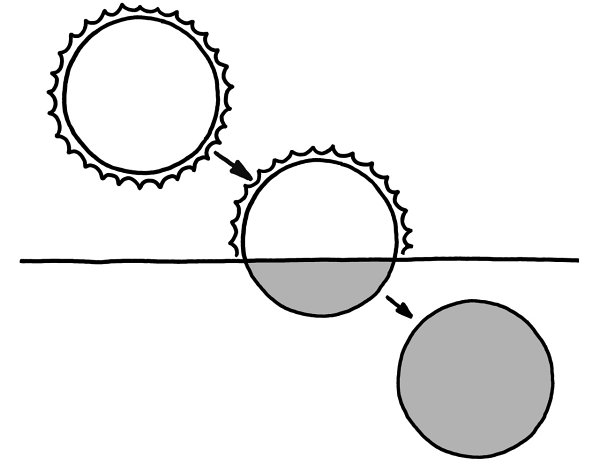
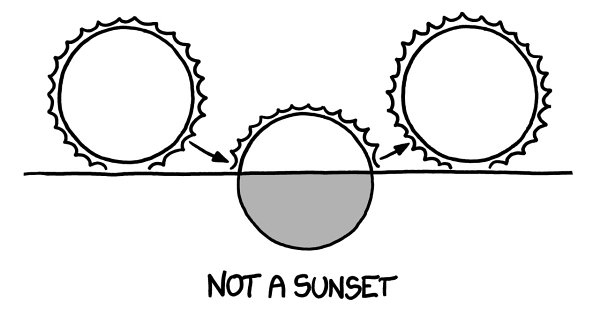
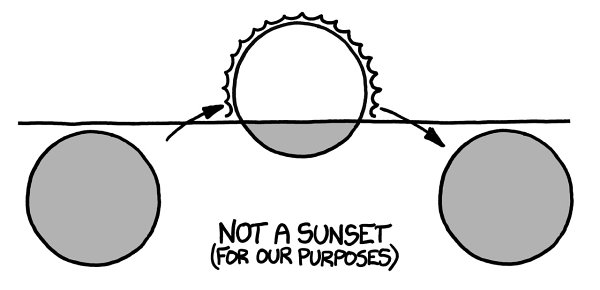
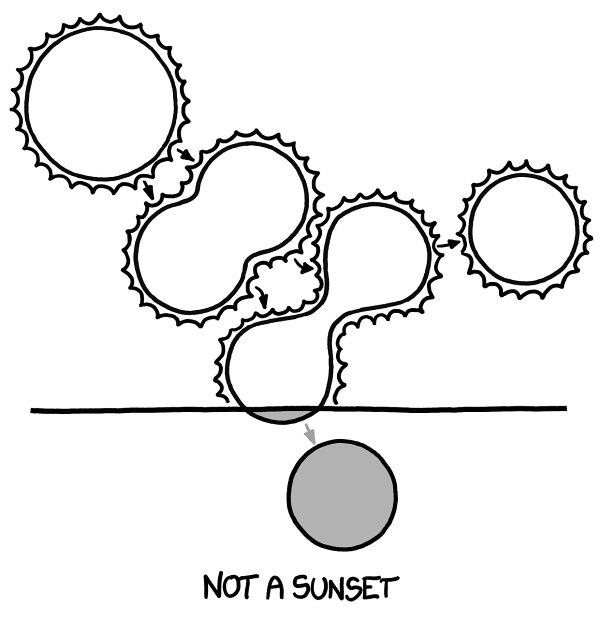
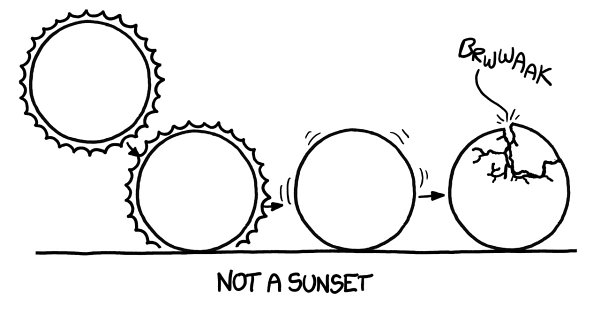
Sunset starts the instant the Sun touches the horizon, and ends when it disappears completely. If the Sun touches the horizon and then lifts back up, the sunset is disqualified.
For a sunset to count, the Sun has to set behind the idealized horizon, not just behind a nearby hill.
Th
is is not a sunset, even though it seems like one:
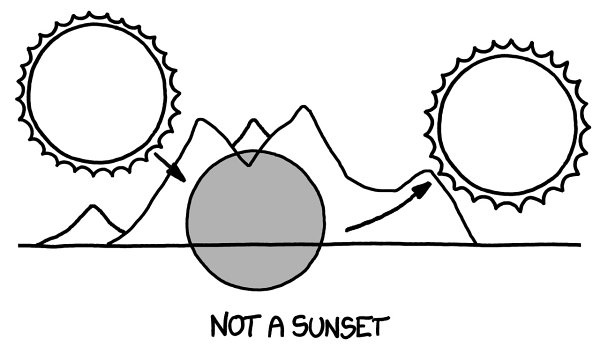
Th
e reason it can’t count as a sunset is that if you could use arbitrary obstacles, you could cause a sunset at any time by hiding behind a rock.
We also have to consider refraction.
Th
e Earth’s atmosphere bends light, so when the Sun is at the horizon it appears about one Sun-width higher than it would otherwise.
Th
e standard practice seems to be to include the average effect
of this in all calculations, which I’ve done here.
At the equator in March and September, sunset is a hair over two minutes long. Closer to the poles, in places like London, it can take between 200 and 300 seconds. It’s shortest in spring and fall (when the Sun is over the equator) and longest in the summer and winter.
If you stand still at the South Pole in early March, the Sun stays
in the sky all day, making a full circle just above the horizon. Sometime around March 21, it touches the horizon for the only sunset of the year.
Th
is sunset takes 38–40 hours, which means it makes more than a full circuit around the horizon while setting.
But Michael’s question was very clever. He asked about the longest sunset you can experience on a paved road.
Th
ere’s a road to the research
station at the South Pole, but it’s not paved
—
it’s made of packed snow.
Th
ere are no paved roads anywhere near either pole.
Th
e closest road to either pole that really qualifies as paved is probably the main road in Longyearbyen, on the island of Svalbard, Norway. (
Th
e end of the airport runway in Longyearbyen gets you slightly closer to the pole, although driving a car there might get you
in trouble.)
Longyearbyen is actually closer to the North Pole than McMurdo Station in Antarctica is to the South Pole.
Th
ere are a handful of military, research, and fishing stations farther north, but none of them have much in the way of roads; just airstrips, which are usually gravel and snow.
If you putter around downtown Longyearbyen,
1
the longest sunset you could experience would
be a few minutes short of an hour. It doesn’t actually matter if you drive or not; the town is too small for your movement to make a difference.
But if you head over to the mainland, where the roads are longer, you can do even better.
If you start driving from the tropics and stay on paved roads, the farthest north you can get is the tip of European Route 69 in Norway.
Th
ere are a number
of roads crisscrossing northern Scandinavia, so that seems like a good place to start. But which road should we use?
Intuitively, it seems like we want to be as far north as possible.
Th
e closer we are to the pole, the easier it is to keep up with the Sun.
Unfortunately, it turns out keeping up with the Sun isn’t a good strategy. Even in those high Norwegian latitudes, the Sun is just
too fast. At the tip of European Route 69
—
the farthest you can get from the equator while driving on paved roads
—
you’d still have to drive at about half the speed of sound to keep up with the Sun. (And E69 runs north-south, not east-west, so you’d drive into the Barents Sea anyway.)
Luckily, there’s a better approach.
If you’re in northern Norway on a day when the Sun just barely sets
and then rises again, the terminator (day-night line) moves across the land in this pattern:
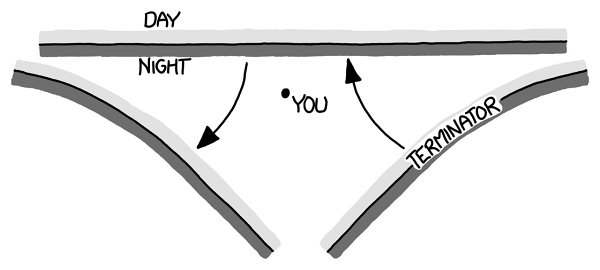
(Not to be confused with the Terminator, which moves across the land in this pattern:)

I can’t decide which terminator I’d rather have to run from.
To get a long sunset, the strategy is simple: Wait for the date when the terminator will just barely reach your position. Sit in your car until the terminator reaches you, drive north to stay a little ahead of it for as long as you can (depending on the local road layout), then U-turn and drive back south fast enough
that you can get past it to the safety of darkness.
2
Surprisingly, this strategy works about equally well anywhere inside the Arctic Circle; so you can get this lengthy sunset on many roads across Finland and Norway. I ran a search for long-sunset driving paths using PyEphem and some GPS traces of Norwegian highways. I found that over a wide range of routes and driving speeds, the longest
sunset was consistently about 95 minutes
—
an improvement of about 40 minutes over the Svalbard sit-in-one-place strategy.
But if you are stuck in Svalbard and want to make the sunset
—
or sunrise
—
last a little longer, you can always try spinning counterclockwise.
3
It’s true that it will add only an immeasurably small fraction of a nanosecond to the Earth’s clock. But depending on who you’re with
. . .

